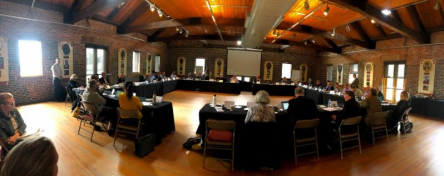A cross section of private investment companies, private restoration companies, and the Chesapeake region’s land conservation community explore the potential for private capital to support land conservation, last week in Baltimore. (Photo: Alliance for the Chesapeake Bay)
Limitations to public and philanthropic funding, coupled with a range of threats to our environment, compounded by climate change, have led to much excitement and speculation about the potential for private sources of financing to engage in environmental conservation and restoration.
The concept of private, profit-seeking investment in conservation is not new, but it is also not a particularly mature space. One of the key unanswered questions is whether environmental outcomes can be achieved alongside market-rate or below market-rate financial returns for investors? If so, it would need to happen on a large scale – billions of dollars in a place like the Chesapeake Bay watershed.
On April 29, the Alliance for the Chesapeake Bay, Chesapeake Conservation Partnership, and Land Trust Alliance co-sponsored a one day Round Table in Baltimore to explore ways to better connect private capital investment, restoration and land conservation going forward.
The session was facilitated by Tim Male, CEO of the non profit company, The Environmental Policy Innovation Center. Over 40 people participated and represented a cross section of private investment companies, private restoration companies, and the land conservation community, both land trusts and federal, state and local governments from around the region.
The morning sessions involved overviews of the growing trend for private investment companies to allocate funds for land acquisition and restoration, followed by facilitated discussions on two topics: (1) what are the conditions needed to attract private capital investment on land conservation and restoration, and (2) what are the most substantial land conservation and restoration unmet needs in the Chesapeake Bay region which would benefit from private investment to address those needs at scale?
In the afternoon participants discussed common questions and area specific ideas for future actions to further the goals of the meeting. Stay tuned for distribution of summaries of the day’s proceedings, including follow up actions.
Participants were enthusiastic about learning and contributing and believed the round table was long overdue. Some attendees have already been organizing follow up discussions.
Here’s a link to helpful background information on private capital investment that was shared during the meeting. Exploring and facilitating the development of new conservation financing sources is a priority of the Chesapeake Conservation Partnership.
Lightning Update is a regular communication of the Chesapeake Conservation Partnership. Any opinions expressed are those of the authors and do not necessarily reflect positions of the Partnership or member organizations.
To share a success story, news, or important event, send your information to:
Support for the Chesapeake Conservation Partnership is provided by:
National Park Service Chesapeake
EPA Chesapeake Bay Program
USDA Forest Service
Pennsylvania Department of Conservation & Natural Resources
Maryland Department of Natural Resources
Virginia Outdoors Foundation
US Fish & Wildlife Service
Chesapeake Conservancy
The Chesapeake Conservation Partnership is co-convened by:




